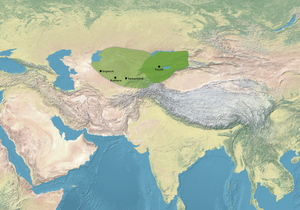
Back قراخانيون Arabic Qarakhánides AST Qaraxanlılar dövləti Azerbaijani قاراخانلیلار AZB Караханиди Bulgarian Qarakhànida Catalan Karachaniden German Χανάτο των Καραχανιδών Greek Karaĥanida Ĥanlando Esperanto Karajánidas Spanish
Kara-Khanid Khanate | |||||||||||||||||||
|---|---|---|---|---|---|---|---|---|---|---|---|---|---|---|---|---|---|---|---|
| 840–1212 | |||||||||||||||||||
Kara Khanid Khanate, c. 1000.[1] | |||||||||||||||||||
| Status |
| ||||||||||||||||||
| Capital | |||||||||||||||||||
| Common languages |
| ||||||||||||||||||
| Religion |
| ||||||||||||||||||
| Government | Monarchy (diarchy) | ||||||||||||||||||
| Khagan | |||||||||||||||||||
• 840–893 (first) | Bilge Kul Qadir Khan | ||||||||||||||||||
• 1204–1212 (last) | Uthman Ulugh-Sultan | ||||||||||||||||||
| Hajib (chancellor) | |||||||||||||||||||
• 11th century | Yūsuf Balasaguni | ||||||||||||||||||
| History | |||||||||||||||||||
• Established | 840 | ||||||||||||||||||
• Disestablished | 1212 | ||||||||||||||||||
| |||||||||||||||||||
The Kara-Khanid Khanate (Persian: قراخانیان, romanized: Qarākhāniyān; Chinese: 喀喇汗國; pinyin: Kālā Hánguó), also known as the Karakhanids, Qarakhanids, Ilek Khanids[10] or the Afrasiabids (Persian: آل افراسیاب, romanized: Āl-i Afrāsiyāb, lit. 'House of Afrasiab'), was a Karluk Turkic khanate that ruled Central Asia from the 9th to the early 13th century. The dynastic names of Karakhanids and Ilek Khanids refer to royal titles with Kara Khagan being the most important Turkic title up until the end of the dynasty.[11]
The Khanate conquered Transoxiana in Central Asia and ruled it independently between 999 and 1089. Their arrival in Transoxiana signaled a definitive shift from Iranic to Turkic predominance in Central Asia,[12] yet the Kara-khanids gradually assimilated the Perso-Arab Muslim culture, while retaining some of their native Turkic culture.[8] The Khanate split into the Eastern and Western Khanates in the 1040s. In the late 11th century, they came under the suzerainty of the Seljuk Empire followed by the Qara Khitai (Western Liao dynasty) who defeated the Seljuks in the Battle of Qatwan in 1141. The Eastern Khanate ended in 1211, and the Western Khanate was extinguished by the Khwarazmian Empire in 1212.[13][14]
The capitals of the Kara-Khanid Khanate included Kashgar, Balasagun, Uzgen and Samarkand. The history of the Kara-Khanid Khanate is reconstructed from fragmentary and often contradictory written sources, as well as studies on their coinage.[2]
- ^ Abazov, R. (2016). Palgrave Concise Historical Atlas of Central Asia. Springer. p. 56. ISBN 978-0-230-61090-3.
- ^ a b c Asimov 1998, pp. 119–144.
- ^ Barthold, V.V. (1962). Four Studies on the History of Central Asia. E.J. Brill. p. 99.
- ^ Grousset 2004, p. 165.
- ^ Pozzi, Janhunen & Weiers 2006, p. 114.
- ^ Svatopluk Soucek (2000). A history of inner Asia. p. 89.
- ^ Kemal Silay (1996). An Anthology of Turkish Literature. p. 27.
- ^ a b Biran, Michal (2012). "Ilak-Khanids". Encyclopedia Iranica. Archived from the original on September 9, 2015. Retrieved May 12, 2014.
The two last western ḵāqāns, Ebrāhim b. Ḥo-sayn (1178–1203) and ʿOṯmān (1202–12), wrote poetry in Persian
- ^ Cite error: The named reference
ESwas invoked but never defined (see the help page). - ^ "Qara-khanids", Encyclopedia of the Peoples of Africa and the Middle East, Vol. 1, Ed. Jamie Stokes, (Infobase Publishing, 2009), p. 578.
- ^ Asimov 1998, p. 120.
- ^ Soucek 2000.
- ^ "Encyclopædia Britannica". Archived from the original on 2008-12-02. Retrieved 2006-12-08.
- ^ Grousset 2004, p. 168.

